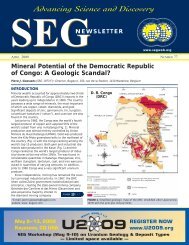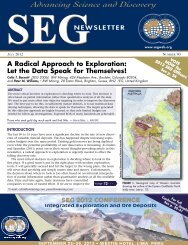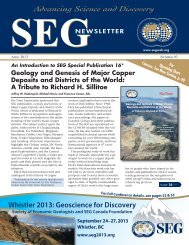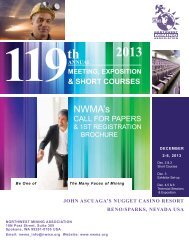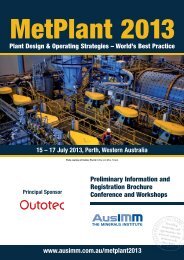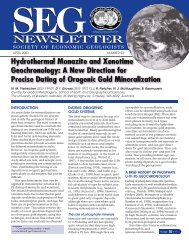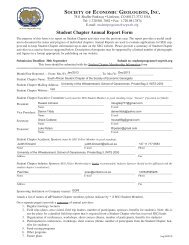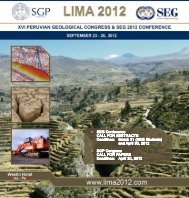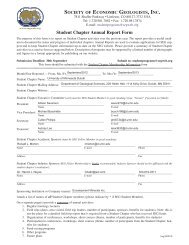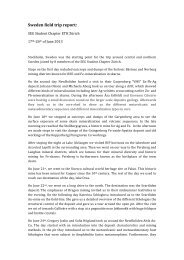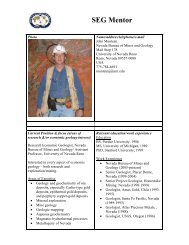SEG 45 Final_qx4 - Society of Economic Geologists
SEG 45 Final_qx4 - Society of Economic Geologists
SEG 45 Final_qx4 - Society of Economic Geologists
You also want an ePaper? Increase the reach of your titles
YUMPU automatically turns print PDFs into web optimized ePapers that Google loves.
16 <strong>SEG</strong> NEWSLETTER No 55 • OCTOBER 2003<br />
Report on the UNESCO-<strong>SEG</strong> International Metallogeny Course<br />
June 1–14 • Quito, Ecuador<br />
<strong>SEG</strong> NEWS<br />
Success Drives Expansion: Course to be Offered outside Ecuador<br />
The 2003 UNESCO-<strong>SEG</strong> Metallogeny<br />
Course held at the Universidad Central<br />
de Ecuador on June 1–14, 2003, was<br />
attended by 55 participants, including<br />
37 non-Ecuadorians (Peru, Argentina,<br />
Chile, Colombia, Mexico, Cuba, and<br />
Brazil were represented, in order <strong>of</strong> numbers<br />
that Latin American Ph.D. students<br />
currently in the United States, Canada,<br />
and Australia). Twenty-eight attendees<br />
received support from the Swiss Agency<br />
for Development and Cooperation (SDC-<br />
KFPE), UNESCO, <strong>SEG</strong> and the<br />
Universidad Central. The group was a<br />
good mixture <strong>of</strong> industry (17), academia<br />
(28), and geological surveys (10).<br />
Topics covered in the 2003 edition<br />
included tectonomagmatic controls on<br />
porphyry and epithermal deposits in<br />
the central Andes (Jeremy Richards,<br />
University <strong>of</strong> Alberta, 2003 <strong>SEG</strong><br />
International Exchange Lecturer);<br />
epithermal deposits (Jeff Hedenquist,<br />
Colorado School <strong>of</strong> Mines), structural<br />
controls on epithermal deposits (Peter<br />
Lewis, Vancouver), overview <strong>of</strong> lead isotope<br />
signatures and metallogeny <strong>of</strong><br />
Ecuador (Massimo Chiaradia, Leeds,<br />
UK; Bernardo Beate and Arturo Eguez,<br />
Universidad Politécnica, Quito); the<br />
Nambija gold skarns (Lluís Fontboté,<br />
Agnès Markowski, Jean Vallance,<br />
Geneva, Switzerland, and Massimo<br />
Chiaradia, Leeds, UK), and the Zaruma-<br />
Portovelo intermediate sulfidation gold<br />
deposits (Richard Spencer, IAMGOLD,<br />
Quito). Participants received, in addition<br />
to the printed course notes, a CD-<br />
ROM with most <strong>of</strong> the presentations in<br />
Powerpoint and as pdf files.<br />
After six days <strong>of</strong> classroom sessions<br />
in Quito, 33 participants attended a<br />
one-week field trip to the Nambija gold<br />
skarns, the Zaruma-Portovelo gold<br />
deposits (where we were host <strong>of</strong><br />
IAMGOLD), and the Au-rich VHMS<br />
deposit <strong>of</strong> La Plata, currently owned by<br />
Sultana del Condor Minera. The field<br />
guide, including abundant graphics, is<br />
accessible at the course website,<br />
.<br />
The metallogeny course is about to<br />
undergo major changes. It will now<br />
travel around Latin America, so that<br />
Lluís Fontboté (<strong>SEG</strong> 1990 F)<br />
training available in this part <strong>of</strong> the<br />
world will be even more extensive.<br />
Other benefits will be the access to a<br />
larger pool <strong>of</strong> lecturers as well as many<br />
new field areas to visit. In addition,<br />
there should be opportunities for<br />
increased support from companies<br />
located in each host country, not to<br />
mention support from rotating host<br />
institutions. The designated 2004 international<br />
course coordinator, Fernando<br />
Tornos (IGME, Salamanca, Spain), is in<br />
contact with several centers <strong>of</strong> economic<br />
geology in the southern part <strong>of</strong> the<br />
region. Expressions <strong>of</strong> interest in hosting<br />
the UNESCO-<strong>SEG</strong> Metallogeny<br />
Course for future years are welcome.<br />
As coordinator <strong>of</strong> the 2003 edition, I<br />
would like to especially acknowledge<br />
the Universidad Central de Ecuador for<br />
its 22 years <strong>of</strong> hosting, in Quito, the<br />
“Curso Internacional de Postgrado en<br />
Metalogenia,” supported by UNESCO<br />
(and since 1999, also by <strong>SEG</strong>), as well as<br />
all instructors, sponsors, and companies<br />
that have made the course possible.<br />
Last but not least, I would like to thank<br />
the 55 participants for the interest and<br />
enthusiasm expressed by their<br />
endurance <strong>of</strong> the very long classroom<br />
program (sessions from 8 a.m. to 7<br />
p.m.!).<br />
Contact addresses and further information<br />
on past and future editions <strong>of</strong><br />
the UNESCO-<strong>SEG</strong> Metallogeny Course<br />
can be obtained from the web page,<br />
.1<br />
FIGURE 1. UNESCO-<strong>SEG</strong> Course participants at the Universidad Central, Quito. Names are<br />
available at the website .<br />
FIGURE 2. Crossing the Zamora River at Ramirez near Nambija on the Universidad Central<br />
bus.



